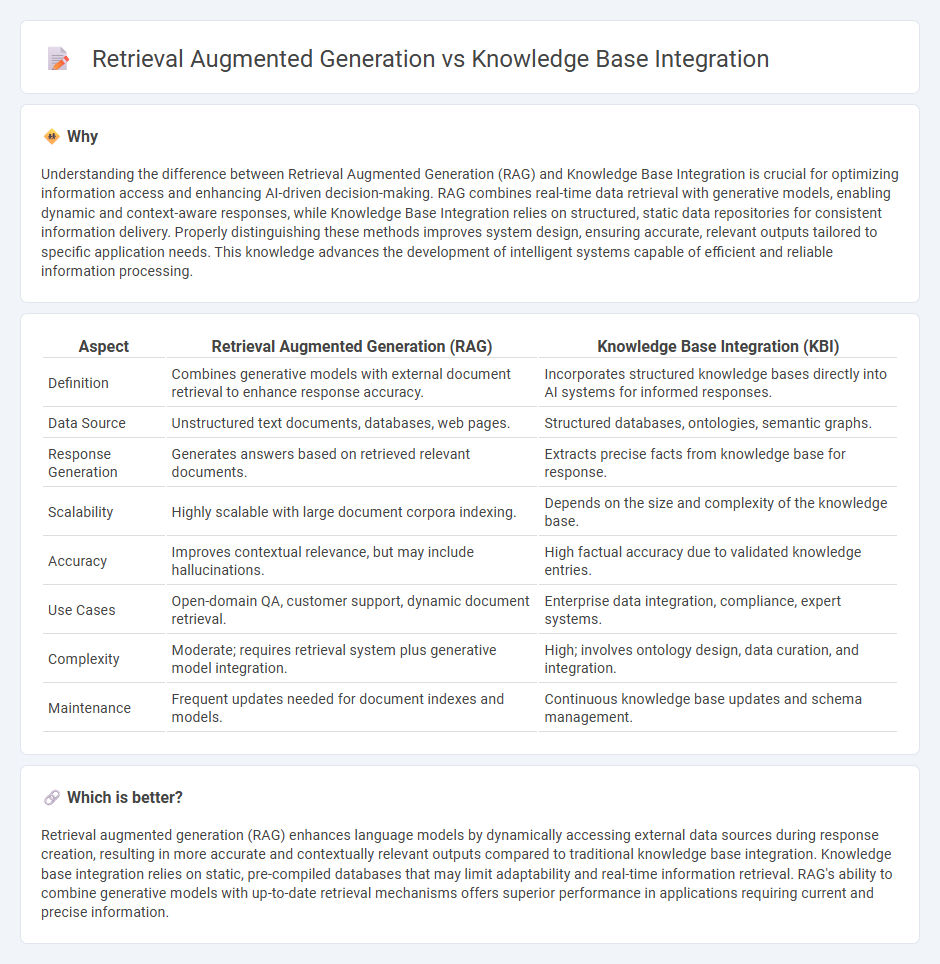
Retrieval Augmented Generation (RAG) leverages large language models combined with external document retrieval systems to generate contextually accurate and up-to-date responses. Knowledge Base Integration (KBI) involves embedding structured databases or ontologies into AI systems to provide precise and reliable information retrieval. Explore the differences and benefits of RAG and KBI to enhance your AI solutions.
Why it is important
Understanding the difference between Retrieval Augmented Generation (RAG) and Knowledge Base Integration is crucial for optimizing information access and enhancing AI-driven decision-making. RAG combines real-time data retrieval with generative models, enabling dynamic and context-aware responses, while Knowledge Base Integration relies on structured, static data repositories for consistent information delivery. Properly distinguishing these methods improves system design, ensuring accurate, relevant outputs tailored to specific application needs. This knowledge advances the development of intelligent systems capable of efficient and reliable information processing.
Comparison Table
| Aspect | Retrieval Augmented Generation (RAG) | Knowledge Base Integration (KBI) |
|---|---|---|
| Definition | Combines generative models with external document retrieval to enhance response accuracy. | Incorporates structured knowledge bases directly into AI systems for informed responses. |
| Data Source | Unstructured text documents, databases, web pages. | Structured databases, ontologies, semantic graphs. |
| Response Generation | Generates answers based on retrieved relevant documents. | Extracts precise facts from knowledge base for response. |
| Scalability | Highly scalable with large document corpora indexing. | Depends on the size and complexity of the knowledge base. |
| Accuracy | Improves contextual relevance, but may include hallucinations. | High factual accuracy due to validated knowledge entries. |
| Use Cases | Open-domain QA, customer support, dynamic document retrieval. | Enterprise data integration, compliance, expert systems. |
| Complexity | Moderate; requires retrieval system plus generative model integration. | High; involves ontology design, data curation, and integration. |
| Maintenance | Frequent updates needed for document indexes and models. | Continuous knowledge base updates and schema management. |
Which is better?
Retrieval augmented generation (RAG) enhances language models by dynamically accessing external data sources during response creation, resulting in more accurate and contextually relevant outputs compared to traditional knowledge base integration. Knowledge base integration relies on static, pre-compiled databases that may limit adaptability and real-time information retrieval. RAG's ability to combine generative models with up-to-date retrieval mechanisms offers superior performance in applications requiring current and precise information.
Connection
Retrieval augmented generation (RAG) enhances natural language processing by combining large language models with external knowledge bases to improve response accuracy and relevance. This integration allows RAG systems to retrieve pertinent information from structured or unstructured databases, effectively grounding generated text in factual data. Leveraging knowledge base integration, RAG overcomes limitations of static training data, enabling more dynamic and context-aware content generation.
Key Terms
**Knowledge Base Integration:**
Knowledge Base Integration involves embedding structured and unstructured data from diverse sources into a coherent, centralized system to enhance the accuracy and relevance of AI-driven responses. This approach enables seamless access to up-to-date information by linking databases, ontologies, and content repositories, thus supporting robust knowledge management and contextual understanding. Explore the benefits and implementation strategies of Knowledge Base Integration to optimize your AI solutions.
Data Mapping
Knowledge base integration centralizes structured data within an organized repository, enabling precise data mapping through explicitly defined relationships and schemas. Retrieval Augmented Generation (RAG) enhances language model outputs by dynamically accessing unstructured or semi-structured external data, relying on approximate retrieval rather than strict schema-based mapping. Explore the distinctions in data mapping techniques and applications to understand their impact on intelligent information systems.
API Connectivity
Knowledge base integration involves directly linking APIs to internal databases or content repositories, allowing seamless real-time access and updates, whereas retrieval augmented generation (RAG) uses APIs to query external or dynamic data sources, enhancing the generation accuracy with relevant documents. API connectivity in knowledge base integration emphasizes stable, structured data exchange protocols like REST or GraphQL to ensure synchronized information flow, while RAG APIs focus on flexible query handling and rapid data retrieval to support natural language processing models. Explore the latest advancements in API connectivity for both approaches to optimize your AI-driven information systems.
Source and External Links
Knowledge integration - Wikipedia - Knowledge base integration involves synthesizing multiple knowledge models into a common framework, allowing incorporation and modification of new information with existing knowledge for a unified understanding, and can include techniques like semantic matching to facilitate effective integration.
Creating a knowledge base through integrations - Zoom Support - Integrating systems such as CRM with a knowledge base transforms stored information into a centralized resource, enabling customer support teams to access accurate and current knowledge for improved service; integrations can be managed via AI Studio with options for custom scripting and generative AI.
Knowledge Base Automation: How to Empower your Customers? - Intercom - Knowledge base integration with AI-powered chatbots enables automated, intelligent self-service for customers by allowing chatbots to access and utilize well-structured knowledge content; effective integration should support flexible article types, customizable layouts, and synchronization with help desks and messaging platforms for seamless information flow.
 dowidth.com
dowidth.com